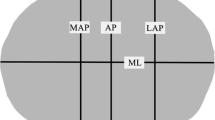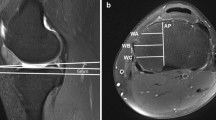Abstract
Purpose
The aim of the study was to make an anthropometric analysis at the resected surfaces of the proximal tibia in the Turkish population and to compare the data with the dimensions of tibial components in current use. We hypothesized that tibial components currently available on the market do not fulfil the requirements of this population and a new tibial component design may be required, especially for female patients with small stature.
Methods
Anthropometric data from the proximal tibia of 226 knees in 226 Turkish subjects were measured using magnetic resonance imaging. We measured the mediolateral, middle anteroposterior, medial and lateral anteroposterior dimensions and the aspect ratio of the resected proximal tibial surface. All morphological data were compared with the dimensions of five contemporary tibial implants, including asymmetric and symmetric design types.
Results
The dimensions of the tibial plateau of Turkish knees demonstrated significant differences according to gender (P < 0.05). Among the different tibial implants reviewed, neither asymmetric nor symmetric designs exhibited a perfect conformity to proximal tibial morphology in size and shape. The vast majority of tibial implants involved in this study tend to overhang anteroposteriorly, and a statistically significant number of women (21 %, P < 0.05) had tibial anteroposterior diameters smaller than the smallest available tibial component.
Conclusion
Tibial components designed according to anthropometric measurements of Western populations do not perfectly meet the requirements of Turkish population. These data could provide the basis for designing the optimal and smaller tibial component for this population, especially for women, is required for best fit.
Level of evidence
II.







Similar content being viewed by others
References
Bindelglass DF, Dorr LD (1998) Symmetry versus asymmetry in the design of total knee femoral components-an unsolved controversy. J Arthroplasty 13:939–944
Bloebaum RD, Bachus KN, Mitchell W, Hofmann G, Hofmann AA (1994) Analysis of the bone surface area in resected tibia. Implications in tibial component subsidence and fixation. Clin Orthop Relat Res 309:2–10
Bonnin MP, Schmidt A, Basiglini L, Bossard N, Dantony E (2013) Mediolateral oversizing influences pain, function, and flexion after TKA. Knee Surg Sports Traumatol Arthrosc 21(10):2314–2324
Canale ST (2003) Campbell’s operative orthopaedics, 10th edn, vol 1.Mosby, Philadelphia, p 292
Chau R, Gulati A, Pandit H, Beard DJ, Price AJ, Dodd CA, Gill HS, Murray DW (2009) Tibial component overhang following unicompartmental knee replacement-does it matter? Knee 16:310–313
Cheng CK, Lung CY, Lee YM, Huang CH (1999) A new approach of designing the tibial base plate of total knee prostheses. Clin Biomech 14:112–117
Cheng FB, Ji XF, Lai Y, Feng JC, Zheng WX, Sun YF, Fu YW, Li YQ (2009) Three dimensional morphometry of the knee to design the total knee arthroplasty for Chinese population. Knee 16(5):341–347
Clary C, Aram L, Deffenbaugh D, Heldreth M (2014) Tibial base design and patient morphology affecting tibial coverage and rotational alignment after total knee arthroplasty. Knee Surg Sports Traumatol Arthrosc 22(12):3012–3018
Crockarell JR Jr, Hicks JM, Schroeder RJ, Guyton JL, Harkess JW, Lavelle DG (2010) Total knee arthroplasty with asymmetric femoral condyles and tibial tray. J Arthroplasty 25(1):108–113
Dai Y, Scuderi GR, Bischoff JE, Bertin K, Tarabichi S, Rajgopal A (2014) Anatomic tibial component design can increase tibial coverage and rotational alignment accuracy: a comparison of six contemporary designs. Knee Surg Sports Traumatol Arthrosc 22:2911–2923
Dennis DA (2004) Evaluation of painful total knee arthroplasty. J Arthroplasty 19(4 Suppl 1):35–40
Güleç E, Akın G, Sagir M, Koca Özer B, Gültekin T, Bektaş Y (2009) Anthropometric dimensions of Anatolian people: results of 2005 Turkish Anthropometric Survey.[Article in Turkish]. Ankara Üniversitesi Dil ve Tarih-Coğrafya Fakültesi Dergisi 49:187–201
Harwin SF (1998) Patellofemoral complications in symmetrical total knee arthroplasty. J Arthroplasty 13:753–762
Hitt K, Shurman JR 2nd, Greene K, McCarthy J, Moskal J, Hoeman T, Mont MA (2003) Anthropometric measurements of the human knee: correlation to the sizing of current knee arthroplasty systems. J Bone Joint Surg Am 85-A(Suppl 4):115–122
Ho WP, Cheng CK, Liau JJ (2006) Morphometrical measurements of resected surface of femurs in Chinese knees: correlation to the sizing of current femoral implants. Knee 13:12–14
Incavo SJ, Ronchetti PJ, Howe JG, Tranowski JP (1994) Tibial plateau coverage in total knee arthroplasty. Clin Orthop Relat Res 299:81–85
Insall JN (1993) Surgical techniques and instrumentation in total knee arthroplasty. In: Insall JN, Windsor RE, Scott WN et al (eds) Surgery of the knee, 2nd edn. Churchill Livingstone, New York, p 739
Insall JN, Dorr LD, Scott RD, Scott WN (1989) Rationale of the Knee Society clinical rating system. Clin Orthop Relat Res 248:13–14
Küçükdurmaz F, Tuncay I, Elmadağ M, Tunçer N (2014) Morphometry of the medial tibial plateau in Turkish knees: correlation to the current tibial components of unicompartmental knee arthroplasty. Acta Orthop Traumatol Turc 48:147–151
Kwak DS, Surendran S, Pengatteeri YH, Park SE, Choi KN, Gopinathan P, Han SH, Han CW (2007) Morphometry of the proximal tibia to design the tibial component of total knee arthroplasty for the Korean population. Knee 14(4):295–300
Lwanga SK, Lemeshaw S (1991) Sample size determination in health studies: a practical manual. World Health Organization, Geneva
Mahoney OM, Kinsey T (2010) Overhang of the femoral component in total knee arthroplasty: risk factors and clinical consequences. J Bone Joint Surg Am 95:1115–1121
Mensch JS, Amstutz HC (1975) Knee morphology as a guide to knee replacement. Clin Orthop Relat Res 112:231–241
Puthumanapully PK, Harris SJ, Leong A, Cobb JP, Amis AA, Jeffers J (2014) A morphometric study of normal and varus knees. Knee Surg Sports Traumatol Arthrosc 22:2891–2899
Stulberg BN, Dombrowski RM, Froimson M, Easley K (1995) Computed tomography analysis of proximal tibial coverage. Clin Orthop Relat Res 311:148–156
Thienpont E, Becker R (2014) Anthropometric measurements of the knee: time to make it fit. Knee Surg Sports Traumatol Arthrosc 22:2889–2890
Uehara K, Kadoya Y, Kobayashi A, Ohashi H, Yamano Y (2002) Anthropometry of the proximal tibia to design a total knee prosthesis for the Japanese population. J Arthroplasty 17:1028–1032
Urabe K, Miura H, Kuwano T, Matsuda S, Nagamine R, Sakai S, Masuda K, Iwamoto Y (2003) Comparison between the shape of resected femoral sections and femoral prostheses used in total knee arthroplasty in Japanese patients: simulation using three-dimensional computed tomography. J Knee Surg 16:27–33
Vaidya SV, Ranawat CS, Aroojis A, Laud NS (2000) Anthropometric measurements to design total knee prostheses for the Indian population. J Arthroplasty 15:79–85
Wang D, Bakhai A, Del Buono A, Maffulli N (2013) Sample size determination for clinical research. Muscles Ligaments Tendons J 3:116–117
Westrich GH, Agulnick MA, Laskin RS, Haas SB, Sculco TP (1997) Current analysis of tibial coverage in total knee arthroplasty. Knee 4:87–91
Westrich GH, Haas SB, Insall JN, Frachie A (1995) Resection specimen analysis of proximal tibial anatomy based on 100 total knee arthroplasty specimens. J Arthroplasty 10:47–51
Wevers HW, Simurda M, Griffin M, Tarrel J (1994) Improved fit by asymmetric tibial prosthesis for total knee arthroplasty. Med Eng Phys 16:297–300
Yang B, Song CH, Yu JK, Yang YQ, Gong X, Chen LX, Wang YJ, Wang J (2014) Intraoperative anthropometric measurements of tibial morphology: comparisons with the dimensions of current tibial implants. Knee Surg Sports Traumatol Arthrosc 22:2924–2930
Yip DK, Zhu YH, Chiu KY, Ng TP (2004) Distal rotational alignment of the Chinese femur and its relevance in total knee arthroplasty. J Arthroplasty 19:613–619
Yue B, Varadarajan KM, Ai S, Tang Rubash HE, Li G (2011) Differences of anthropometry between Chinese and white men and women. J Arthroplasty 26(1):124–130
Conflict of interest
The author(s) declared no potential conflicts of interest with respect to the research, authorship and/or publication of this article.
Author information
Authors and Affiliations
Corresponding author
Rights and permissions
About this article
Cite this article
Erkocak, O.F., Kucukdurmaz, F., Sayar, S. et al. Anthropometric measurements of tibial plateau and correlation with the current tibial implants. Knee Surg Sports Traumatol Arthrosc 24, 2990–2997 (2016). https://doi.org/10.1007/s00167-015-3609-5
Received:
Accepted:
Published:
Issue Date:
DOI: https://doi.org/10.1007/s00167-015-3609-5




